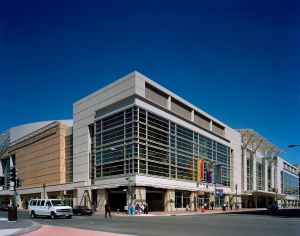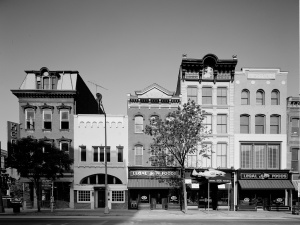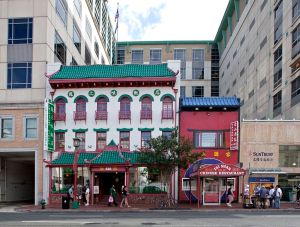
From the year 2000 to the present day, the downtown area of Washington DC has experienced rapid growth in the private sector, known as a “renaissance,” or a “rebirth.” From 2003 to 2006, more than 8,600 condominiums were built in the District.[1] Roughly between 2000 and 2008, developers constructed more than 11 million square feet of office space downtown, accounting for nearly 60 percent of the new commercial office space built in the city.[2] The economic crisis of 2008 in fact increased land value in downtown DC because of the demand for new offices for lobbyists and administrators that the bailout produced.[3] But this renaissance has had questionable impacts on certain sectors of the population, including low-income residents and the homeless.
Perhaps the most celebrated development in the downtown was the MCI Center, now the Verizon Center, in 1995.[4] The sports arena that was built with an original $200 million investment from Wizards team owner Abe Pollin is considered to be the catalyst for downtown’s renaissance. Described as having a “transformative” effect on the area, and as a “mecca for tourists and residents,” the center prompted the construction of restaurants, theaters, and other businesses.[5] Following an initial $79 million of city government funds to improve the infrastructure in the neighborhood, investors spent more than $5 billion and added nearly 10 million square feet of office space. [6]

While the business boom was celebrated by Mayor Marion Barry and DC Council Chairman Jack Evans, who stated that the neighborhood before has been “deserted and dangerous,” others lamented the loss of many ethnic Chinese businesses in the Chinatown area.[7] The Center also brought with it a commitment from the city to provide an additional 50 Metropolitan Police to ease fears of violent crime.[8] While residents had fought for more medium and low-income housing units to be included in the Verizon Center downtown development plan,[9] the agreement that the city ultimately reached promised 1,000 fewer units than the original version, and instead mandated that developers build the equivalent of one story of housing elsewhere in the city for every ten stories of office space built downtown.
New developments in downtown DC were accompanied by efforts on part of the business community to police the area and regulate the uses of public space. Since 1997, DC has developed eight Business Improvement Districts (BID’s). The Downtown BID is DC’s oldest and largest, formed shortly after the construction of the Verizon Center. It was created in 1997 with the opening of the MCI Center at Gallery Place. According to Gerry Widdicombe, director of economic development of the BID in 2008, the BID was created to provide a sense of security and cleanliness to visitors in the previously downtrodden neighborhood.[10] The Downtown BID in DC collects $10 million in taxes from 535 properties spread across 138 blocks.[11] They use that money to pay for private policing and cleaning of the sidewalks and parks in the area.[12]

The efforts to control downtown public spaces have had a significant impact on impoverished people’s ability to use the streets for their own ends. James Shabazz, currently a resident of the CCNV shelter, addresses the dramatic cost that the Downtown BID’s campaign had on the street vendors.[13]
The downtown BID has directly influenced how police officers respond to homeless individuals. This response increasingly involved the removal of homeless individuals from public spaces, such as Franklin Square.[14] In an interview with anthropologist Jennie Marie Simpson, one police officer states:
I feel pressure from everybody. I get pressure from supervisors, which comes from the BIDs, to move people. I get pressure from businesses. But you know what I hate most? Complaints from residents. I want to tell them, “Didn’t you know there was a shelter two blocks away when you bought your condo? [15]
Others, such as Valerie Williams, have perceived an increased level of harassment against the homeless as the police are pressured from the business community.[16]
Downtown development has corresponded to a pattern of market-based growth that has prevailed in cities nationally. The model led the city government to prioritize the development of a posh hotel over the construction of a promised new public library in 2008.[15] The city government has pushed to expand the number of hotel beds rather then the number of of shelter beds.[17]
The high value of downtown property and the eastward push of the central business district has brought with it increasing interest by developers in the area surrounding the Federal City Shelter. When the covenant for the shelter is set to expire in 2016, the surrounding downtown landscape will be a lot different then it had been thirty years earlier. Will the pressures from commercial development outweigh the shelter resident’s claim to downtown space?
[1] Schwartzman, Paul. “Downtown Is Enjoying Renaissance, Report Finds.” Washington Post, November 29, 2007, sec. METRO.
[2] Ibid
[3] Hedgpeth, Dana . “Bailout Raises Demand For Square Feet in D.C.” Washington Post, November 10, 2008, sec. FINANCIAL.
[4] Lipscomb, David C. “ Investment Into Arena Paid off Big Time,” The Washington Times, November 25, 2009, sec. A
[5] Ibid
[6] Ibid
[7] Nakamura, David. “Verizon Center Marks a Decade and a Dramatic Change of Scene.” Washington Post, December 2, 2007, sec. METRO.
[8] Lipscomb, David C.
[9] Ibid
[10] Lyndsey Layton, “Business Groups Fill The Breach; Improvement Districts Springing Up All Over.” Washington Post, September 14, 2006, sec. D.C. Extra.
[11] Ibid
[12] Ibid
[13] Shabazz, James. Interview by Daniel Kerr. Digital Recording. Washington, D.C., March 20, 2013.
[14] Simpson, Jennie Marie, and American University (Washington, D.C.). Policing the New Downtown the Costs of Community for Homeless Persons and Individuals with Mental Illnesses in Washington, D.C. American University: Washington, D.C, 2011S p. 272
[15] Simpson, 273
[16]Williams, Valerie. Interview by StacieNicole Simmons. Digital Recording. Washington, D.C., November 8, 2012.
[17] “Downtown D.C. Project To Include Posh Hotel; Site Was Considered For New Library.” Washington Post, May 13, 2008, sec. METRO B01.
[18] Ibid